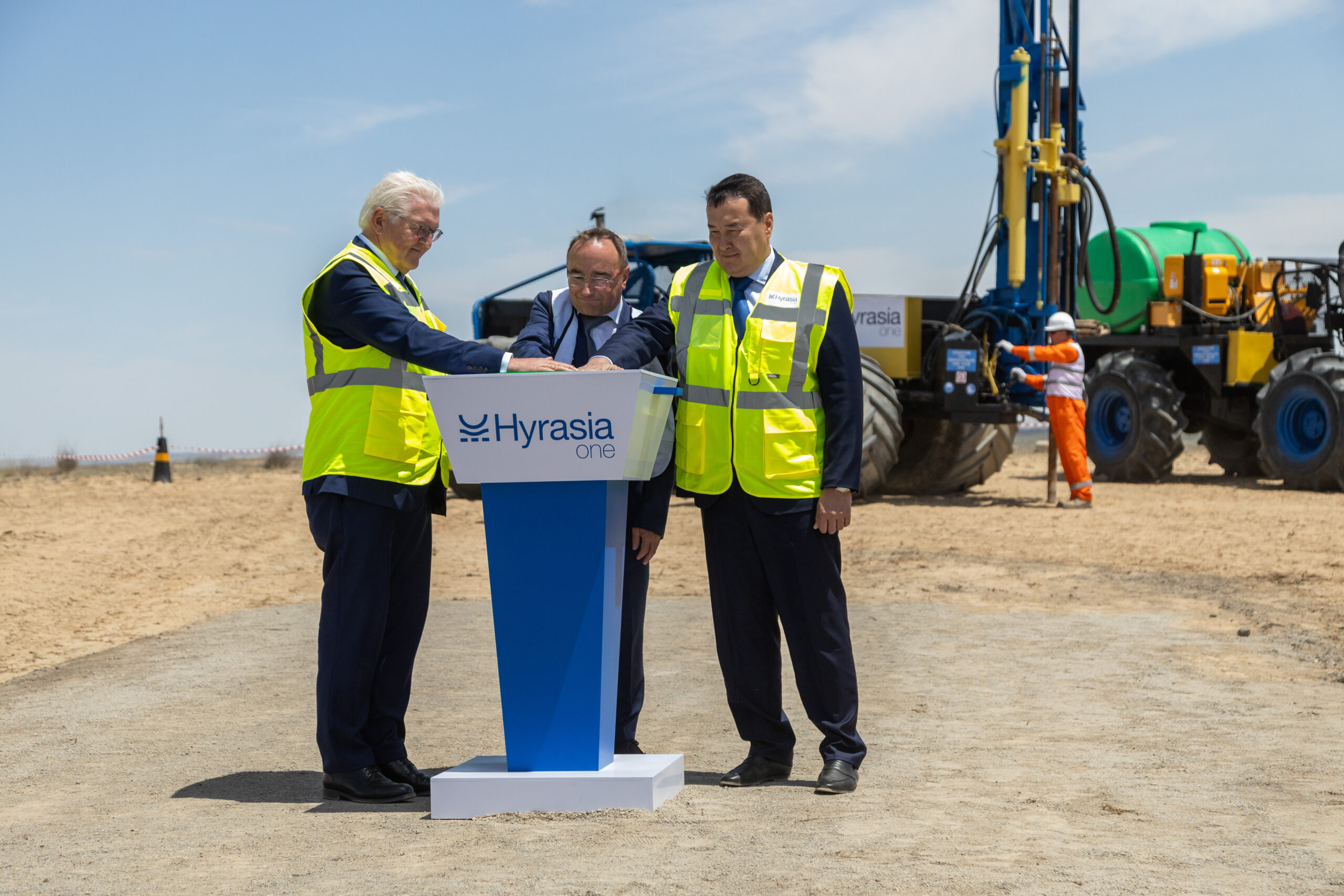Kuryk / Dresden, 21.06.2023 – Hyrasia one, one of the world’s largest renewable hydrogen projects, enters new and exciting project phase. The Preliminary Front-End Engineering and Design (pre-FEED) is a crucial step to minimize risks and to lay the ground work for concrete technical planning of the 40-gigawatt Wind and Solar powered Green Hydrogen plant that will produce up to 2 million tons of Green Hydrogen that can be converted to 11 million tons of Green Ammonia from 2030.
As part of his delegation trip to Kazakhstan, German Federal President Frank-Walter Steinmeier visited Hyrasia one’s future site in the Kazakh Steppe, where he emphasized both the importance of green hydrogen for a successful energy transition, as well as the importance of German-Kazakh energy partnership. President Steinmeier launched the geological drilling of the new project phase together with Kazakh Prime Minister Älihan Smaiylov, and Wolfgang Kropp, CEO of the SVEVIND Energy Group – the European parent company behind Hyrasia one.
The commencement of geological drilling marks a milestone in the development of Hyrasia one: this process will enable the thorough evaluation and assessment of the underground geological formations, providing vital data for the subsequent stages of the project’s further development. The drilling is part of the pre-FEED phase for which the SVEVIND Energy Group now has a strong partner at its side: part of the event in the middle of the Kazakh steppe was the ceremonial signing of a pre-FEED contract with Genesis, wholly owned by the French Engineering and Technology company, Technip Energies. The pre-FEED will run until the end of this year.“I was honored to launch this important project phase side by side with President Steinmeier and Prime Minister Smaiylov”, says CEO Wolfgang Kropp, and emphasizes: “their presence and support underlines the importance of green hydrogen production at scale. What we are creating here is real pioneering work: not a single green hydrogen project of this size has ever been realized. We cannot just procure the equipment and start construction. We are developing something unprecedent and new that needs precise and careful planning and assessment. And we are glad to have an experienced partner for this at our side in Genesis and Technip Energies.”
The pre-FEED is about working out technological decisions, e.g. what type of electrolyzers to use for converting the green electricity in green hydrogen by splitting water. The scope of work of the pre-FEED can be divided into two areas: First, the Pre-FEED for the Renewable Energy System (RES) Parks, i.e. the wind and solar parks. Second, the Pre-FEED for the Industrial Facility for the production of hydrogen and ammonia. The pre-FEED further determines all required technical utilities like among others desalination plants, air separation units, and water management.Technip Energies is a world-leading engineering and technology player for the energy transition and has a 60-year history of engineering and execution for some of the world’s largest projects. Wholly owned by Technip Energies, Genesis is a market-leading consulting company focused on providing high-value advisory services for the energy and renewables sector.Charles Cessot, SVP T.EN X Consulting and Products of Technip Energies commented: “We are pleased to draw on our advisory excellence through our affiliate Genesis to support SVEVIND Energy Group in this ambitious green hydrogen and derivatives project. While strengthening our long-lasting presence in Kazakhstan, this project illustrates the need to bridge the gap between green electrons to molecules to build a sustainable future.”Green hydrogen is fundamental for the energy transition and decarbonization of carbon intensive industries. Hyrasia one harnesses the vast renewable resources of Kazakhstan: ideal wind and sun conditions, directly at the Caspian Sea, with strong Kazakh, German, and European political will behind the project – an optimum combination to realize the ambitions of this development.Hyrasia one is progressing according to plan: following the Investment Agreement with the Kazakh government in October 2022, first environmental impact studies are already being carried out, and the pre-FEED now successfully started. The next milestones are right in front of us: Start of the Environmental Social Impact Assessment, Final Investment Decision in 2026, construction start in 2027, first production and first deliveries in 2030, full capacity utilization planned from 2032 onwards.CEO Kropp says: “With Hyrasia one we will play our part in this green transition. The project will produce hydrogen or ammonia at industrial scale, and it has the potential to supply large amounts to European or Asian markets while still significantly contributing to the green transition of the Kazakh economy.”Combined with large amounts of available raw materials, like metals and rare earths, green energy will create tremendous opportunities to produce high-quality, sustainable products, like green steel, aluminum, fertilizers, and cement in Kazakhstan.“But ensuring the green transformation of industry with green energy is just one transformation that we will contribute to with this project”, continues Kropp: “With Hyrasia one we will create thousands of jobs in the Mangystau region. And we are planning to fill at least 90 percent of these jobs with local workers during the operational phase. For this, of course, we need best-trained engineers. That’s why we initiated the Mangystau School of Sustainable Engineering.”The SVEVIND Energy Group initiated and is partly funding a new study program as academic cooperation between German and Kazakh universities: The Mangystau School for Sustainable Engineering will train young Kazakh’s to become skilled engineers ideally equipped with knowledge to work on sustainability projects like Hyrasia one.

